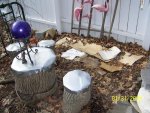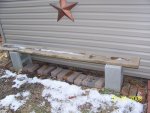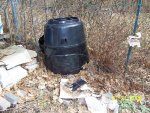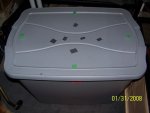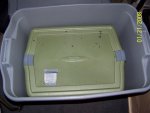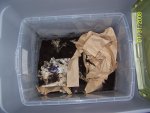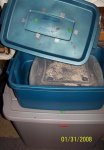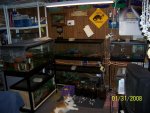Since everyone's talking worms, I thought I'd update my own worm projects.
My outdoor wormeries are great. I can always find worms when I look for them. I created a few new ones this year, starting with a few areas I covered with cardboard. One attracted bees and became a yellow-jacket hive, as I discovered to my unhappiness as I moved the cardboard off and gasped and ran. I created some larger ones, and I never run out of worms until it's too cold for them. I'm still getting them on warm days.
As far as trying to grow my yard worms indoors, I can't even keep them alive! I had such great luck with the red worms, but all summer I've been putting yard worms in my indoor bins and they just die after a while. I tried all kinds of parameters: temperature (too hot? I made it cooler in the basement: I have an air conditioner in my basement now and not even in my living room!), I thought maybe too moist, too dry, I tried all kinds of modifications.
I tried to keep a bunch alive in the fridge for my friend who came over and fed my salamanders when I was on vacation. The ones in the basement bin stayed alive long enough (I can keep them alive for at most 2-3 weeks, then they just die), and I tried putting some in the fridge in a drawer (in a container). After all, the nightcrawlers I buy stay alive in the fridge in their container for months. They all died too. I had been hoping that even if I can't breed outdoor worms, I could at least collect a lot and keep them alive through the winter to feed my sals. If anyone has any tips on at least keeping them alive, whether they breed or not, I'm all ears.
One last word on the air conditioner in my basment: most of the time it's cool enough down there, but when I do my laundry and have the dehumidifier running or I'm down there doing hobbies (it's also my hobby room), I can heat it up with lights and machines. Thus the air conditioner. It keeps it basement temperature all the time, and it's on a temp monitor, so it only goes on if the basement gets above 68 degrees.
If I can't find a way to keep the outdoor worms alive long enough or at all, I'm going to try to raise nightcrawlers, so I'll have small ones to feed my sals whole. But I think my yardworms are the best for them, and I don't want to admit defeat yet.

